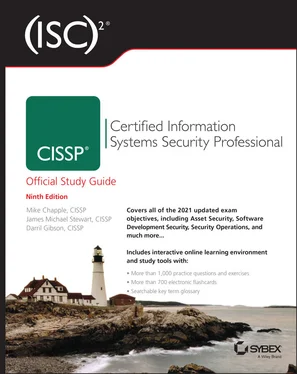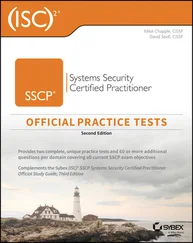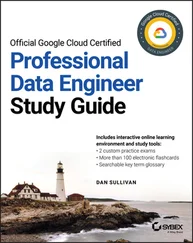Using service-level agreements (SLAs) is a means to ensure that organizations providing services maintain an appropriate level of service agreed on by both the service provider, vendor, or contractor and the customer organization. You'd be wise to put SLAs in place for any data circuits, applications, information processing systems, databases, or other critical components that are vital to your organization's continued viability. SLAs are important when using any type of third-party service provider, including cloud services. SLAs also commonly include financial and other contractual remedies that kick in if the agreement is not maintained. For example, if a critical circuit is down for more than 15 minutes, the service provider might agree to waive all charges on that circuit for one week.
SLAs and vendor, consultant, and contractor controls are an important part of risk reduction and risk avoidance. By clearly defining the expectations and penalties for external parties, everyone involved knows what is expected of them and what the consequences are in the event of a failure to meet those expectations. Although it may be very cost-effective to use outside providers for a variety of business functions or services, it does increase potential risk by expanding the potential attack surface and range of vulnerabilities. SLAs should include a focus on protecting and improving security in addition to ensuring quality and timely services at a reasonable price. Some SLAs are set and cannot be adjusted, whereas with others you may have significant influence over their content. You should ensure that an SLA supports the tenets of your security policy and infrastructure rather than being in conflict with them, which could introduce weak points, vulnerabilities, or exceptions.
Outsourcing is the term often used to describe the use of an external third party, such as a vendor, consultant, or contractor, rather than performing the task or operation in-house. Outsourcing can be used as a risk response option known as transference or assignment (see the “Risk Response” section, later in this chapter). However, though the risk of operating a function internally is transferred to a third party, other risks are taken on by using a third party. This aspect needs to be evaluated as to whether it is a benefit or a consequence of the SLA.
For more on service-level agreements (SLAs), see Chapter 16.
Vendors, consultants, and contractors also represent an increase in risk of trade secret theft or espionage. Outsiders often lack the organizational loyalty that internal employees typically have; thus, the temptation to take advantage of intellectual property access opportunities may seem to a perpetrator easier or less of an internal conflict. For more on espionage, see Chapter 17, “Preventing and Responding to Incidents.”
Some organizations may benefit from a vendor management system (VMS) . A VMS is a software solution that assists with the management and procurement of staffing services, hardware, software, and other needed products and services. A VMS can offer ordering convenience, order distribution, order training, consolidated billing, and more. In regard to security, a VMS can potentially keep communications and contracts confidential, require encrypted and authenticated transactions, and maintain a detailed activity log of events related to vendors and suppliers.
Compliance Policy Requirements
Compliance is the act of conforming to or adhering to rules, policies, regulations, standards, or requirements. Compliance is an important concern of security governance. On a personnel level, compliance is related to whether individual employees follow company policy and perform their job tasks in accordance with defined procedures. Many organizations rely on employee compliance in order to maintain high levels of quality, consistency, efficiency, and cost savings. If employees do not maintain compliance, it could cost the organization in terms of profit, market share, recognition, and reputation. Employees need to be trained in regard to what they need to do (i.e., stay in line with company standards as defined in the security policy and remain in compliance with any contractual obligations such as Payment Card Industry Data Security Standard [PCI DSS] to maintain the ability to perform credit card processing); only then can they be held accountable for violations or lacking compliance. Compliance is a form of administrative or managerial security control because it focuses on policies and people abiding by those policies (as well as whether the IT and physical elements of the organization comply with policies).
Compliance enforcement is the application of sanctions or consequences for failing to follow policy, training, best practices, and/or regulations. Such enforcement efforts could be performed by the chief information security officer (CISO) or chief security officer (CSO), worker managers and supervisors, auditors, and third-party regulators.
Compliance is also a regulation concern. That topic is covered in Chapter 4.
Privacy Policy Requirements
Privacy can be a difficult concept to define. The term is used frequently in numerous contexts without much quantification or qualification. Here are some partial definitions of privacy:
Active prevention of unauthorized access to information that is personally identifiable (that is, data points that can be linked directly to a person or organization), known as personally identifiable information (PII)
Freedom from unauthorized access to information deemed personal or confidential
Freedom from being observed, monitored, or examined without consent or knowledge
When addressing privacy in the realm of IT, there is usually a balancing act between individual rights and the rights or activities of an organization. Some claim that individuals have the right to control whether information can be collected about them and what can be done with it. Others claim that any activity performed in public view—such as most activities performed over the internet or activities performed on company equipment—can be monitored without knowledge of or permission from the individuals being watched, and that the information gathered from such monitoring can be used for whatever purposes an organization deems appropriate or desirable. Some of these issues are determined by law based on country or context, whereas others are left up to organizations and individuals.
Protecting individuals from unwanted observation, direct marketing, and disclosure of private, personal, or confidential details is usually considered a worthy effort. However, some organizations profess that demographic studies, information gleaning, and focused marketing improve business models, reduce advertising waste, and save money for all parties.
There are many legislative and regulatory compliance issues in regard to privacy. Many U.S. regulations—such as the Health Insurance Portability and Accountability Act (HIPAA), the Sarbanes–Oxley Act of 2002 (SOX), the Family Educational Rights and Privacy Act (FERPA), and the Gramm–Leach–Bliley Act—as well as the European Union's General Data Protection Regulation (GDPR) (Regulation [EU] 2016/679)—include privacy requirements. It is important to understand all government regulations that your organization is required to adhere to and ensure compliance, especially in the areas of privacy protection.
Whatever your personal or organizational stance is on the issue of online privacy, it should be addressed in an organizational security policy. Privacy is an issue not just for external visitors to your online offerings but also for your customers, employees, suppliers, and contractors. If you gather any type of information about any person or company, you must address privacy.
Читать дальше












